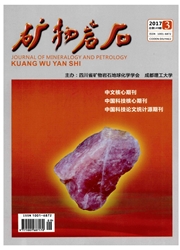

 中文摘要:
中文摘要:
放射性核素固化体备选矿物的研究是高放废弃物处理及其安全性评估的重要方面,但选择理想的人工固化矿物及其评估在地质环境中的安全性一直是一个需要解决的难题。含放射性核素的榍石作为固化核废料的备选矿物,其稳定性对核废物固化体的安全性评估意义重大。通过对北祁连牛心山变质杂岩体中榍石(775Ma)和山西凤凰山花岗岩中榍石(1758Ma)的XRD及EDS等测试与研究,结果表明:两地榍石的杂质元素质量分数高达8.6%~10.91%,放射性核素锶、铯和铀的质量分数达4.26%~4.58%;晶胞参数的变化极小,△a=-0.0009nm~0.0041nm、△b=0.0018nm-0.0004nm、△c=0.0002nm~-0.0048nm、△β=-0.10°~0.09°,结晶度仍高达99.27%~96.46%,榍石经过10×10^8a的地质作用,结晶度仅减少了3%,显示榍石固化放射性系列核素的能力较强,虽经历了约775Ma~1758Ma的复杂地质演化及其所舍放射性核素的衰变作用,其晶体结构完好,稳定性极高,是值得期待的理想核废物固化矿物。
 英文摘要:
英文摘要:
The stability of the sphene, as the selected crystalline solid of radioactive elements, has an important significance for security estimate of the solid, including nucleus waste material. They are discovered by XRD and EDS study of the sphenes from metamorphic rock of the Niuxin hill in north qilian Mountain and Fenghuang Mountain in Shanxi Province. There are 8. 6%- 10.91% foreign matter in the sphenes, in which radioactive elements of strontium, cesium and uranium range from 4.26% to 4.58%. The change of struetural cell parameters of sphenes is still very little,△a=-0.0009nm~0.0041nm、△b=0.0018nm-0.0004nm、△c=0.0002nm~-0.0048nm、△β=-0.10°~0.09° with high crystallinity of 99.27%-96.46%. Though, the age of sphene from the Fenghuang Mountain is about 1 000 Ma, and experienced 775 Ma-1758 Ma geological evolvement and alpha decay, its crystallinity only decreased 3%, and its crystal shape and structure are still fine, indicating that sphene is of good ability to solidify radioactive elements. Therefore, sphenes are ideal minerals for solidifying nucleus waste.
 同期刊论文项目
同期刊论文项目
 同项目期刊论文
同项目期刊论文
 期刊信息
期刊信息
